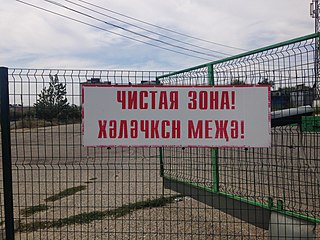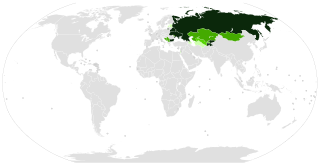
Tatar is a Turkic language spoken by the Volga Tatars mainly located in modern Tatarstan, as well as Siberia and Crimea.
Abaza is a Northwest Caucasian language spoken by Abazins in Russia. The language has gone through several different orthographies based primarily on Latin and Cyrillic letters. Its consonant-to-vowel ratio is remarkably high; making it quite similar to many other languages from the same parent chain. The language evolved in popularity in the mid to late 1800s, but has become an endangered language.

Kalmyk Oirat, commonly known as the Kalmyk language, is a variety of the Oirat language, natively spoken by the Kalmyk people of Kalmykia, a federal subject of Russia. In Russia, it is the standard form of the Oirat language, which belongs to the Mongolic language family. The Kalmyk people of the Northwest Caspian Sea of Russia claim descent from the Oirats from Eurasia, who have also historically settled in Mongolia and Northwest China. According to UNESCO, the language is "Definitely endangered". According to the Russian census of 2021, there are 110,000 speakers of an ethnic population consisting of 178,000 people.
Lezgian, also called Lezgi or Lezgin, is a Northeast Caucasian language. It is spoken by the Lezgins, who live in southern Dagestan (Russia); northern Azerbaijan; and to a much lesser degree Turkmenistan; Uzbekistan; Kazakhstan; Turkey, and other countries. It is a much-written literary language and an official language of Dagestan. It is classified as "vulnerable" by UNESCO's Atlas of the World's Languages in Danger.

Nogai also known as Noğay, Noghay, Nogay, or Nogai Tatar, is a Turkic language spoken in Southeastern European Russia, Kazakhstan, Uzbekistan, Ukraine, Bulgaria, Romania and Turkey. It is the ancestral language of the Nogais. As a member of the Kipchak branch, it is closely related to Kazakh, Karakalpak and Crimean Tatar. In 2014 the first Nogai novel was published, written in the Latin alphabet.

Azerbaijani is the sole official language of Azerbaijan and is spoken by the majority of its population. However, several minority languages also exist in the country, including Lezgian, Talysh, Avar, Russian, and Tat. Additionally, languages such as Tsakhur and Khinalug are spoken by a small percentage of the population.
Shor is a critically endangered Turkic language spoken by about 2,800 people in a region called Mountain Shoriya, in the Kemerovo Province in Southwest Siberia, although the entire Shor population in this area is over 12000 people. Presently, not all ethnic Shors speak Shor and the language suffered a decline from the late 1930s to the early 1980s. During this period the Shor language was neither written nor taught in schools. However, since the 1980s and 1990s there has been a Shor language revival. The language is now taught at the Novokuznetsk branch of the Kemerovo State University.
Hill Mari or Western Mari is a Uralic language closely related to Northwestern Mari and Meadow Mari, in which Hill Mari forms a Western Mari group with the former. Hill Mari is spoken in the Gornomariysky, Yurinsky and Kilemarsky districts of Mari El, Russia. It is written using the Hill Mari Cyrillic script and is co-official with Russian as well as Meadow Mari in the Mari El Republic.
The Nanai language is spoken by the Nanai people in Siberia, and to a much smaller extent in China's Heilongjiang province, where it is known as Hezhe. The language has about 1,400 speakers out of 17,000 ethnic Nanai, but most are also fluent in Russian or Chinese, and mostly use one of those languages for communication.
Tsakhur is a Northeast Caucasian language spoken by the Tsakhurs in northern Azerbaijan and southwestern Dagestan (Russia). It is spoken by about 11,700 people in Azerbaijan and by about 10,600 people in Russia. The word Tsakhur derives from the name of a Dagestani village where speakers of this language make up the majority.

Numerous Cyrillic alphabets are based on the Cyrillic script. The early Cyrillic alphabet was developed in the 9th century AD and replaced the earlier Glagolitic script developed by the theologians Cyril and Methodius. It is the basis of alphabets used in various languages, past and present, Slavic origin, and non-Slavic languages influenced by Russian. As of 2011, around 252 million people in Eurasia use it as the official alphabet for their national languages. About half of them are in Russia. Cyrillic is one of the most-used writing systems in the world. The creator is Saint Clement of Ohrid from the Preslav literary school in the First Bulgarian Empire.

Latin yeru or I with bowl is an additional letter of the Latin alphabet based on the Cyrillic soft sign. It was introduced in 1928 into the reformed Yañalif, and later into other alphabets for Soviet minority languages. The letter was designed specifically to represent the non-front close vowel sounds IPA:[ɨ] and IPA:[ɯ]. Thus, this letter corresponds to the letter ⟨I ı⟩ in modern Turkic alphabets, and the letter yery in Cyrillic.
The Komi language, a Uralic language spoken in the north-eastern part of European Russia, has been written in several different alphabets. Currently, Komi writing uses letters from the Cyrillic script. There have been five distinct stages in the history of Komi writing:
Since its inception in the 18th century and up to the present, it is based on the Cyrillic alphabet to write the Udmurt language. Attempts were also made to use the Latin alphabet to write the Udmurt language. In its modern form, the Udmurt alphabet was approved in 1937.
Evenki orthography is the orthography of the Evenki language.
Nogai writing is a script used to write the Nogai language. During its existence, it has changed its graphic basis several times. Currently, the Nogai script functions in the Cyrillic alphabet. There are 3 stages in the history of Nogai writing:
Mansi alphabets is a writing system used to write Mansi language. During its existence, it functioned on different graphic bases and was repeatedly reformed. At present day, the Mansi writing functions in Cyrillic. There are 3 stages in the history of Mansi writing:
Even alphabets are the alphabets used to write the Even language. During its existence, it functioned on different graphic bases and was repeatedly reformed. At present, Even writing functions in Cyrillic. There are three stages in the history of Even writing:
Udege alphabets are the alphabets used to write the Udege language. During its existence, it functioned on different graphic bases and was repeatedly reformed. Currently, the Udege script functions on two versions of the Cyrillic alphabet for two emerging literary languages, but does not have a generally accepted norm. There are 2 stages in the history of Udege writing:
Nivkh alphabets are the alphabets used to write the Nivkh language. During its existence, it functioned on different graphic bases and was reformed several times. Currently, Nivkh writing functions in Cyrillic. There are 3 stages in the history of Nivkh writing:









